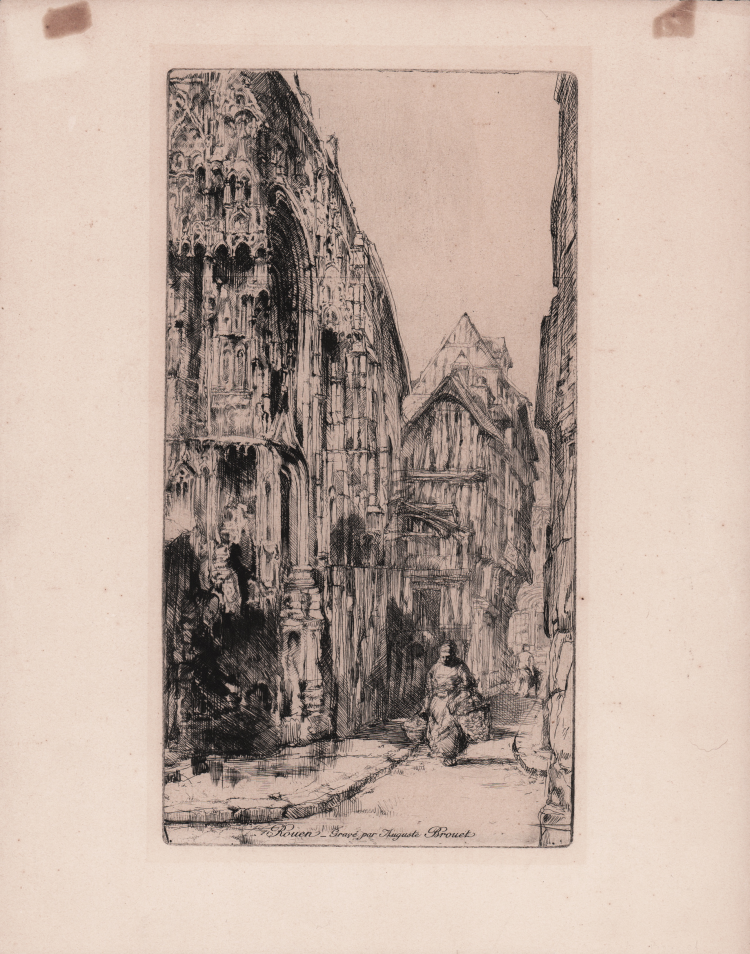



| Reference: | S42130 |
| Author | Auguste BROUET |
| Year: | 1911 ca. |
| Measures: | 130 x 238 mm |


| Reference: | S42130 |
| Author | Auguste BROUET |
| Year: | 1911 ca. |
| Measures: | 130 x 238 mm |
Acquaforte, 1911 circa, firmato in basso nell’immagine: Rouen Gravé par Auguste Brouet.
Esemplare nel quarto stato finale, dopo il taglio della lastra, con l’iscrizione aggiunta in basso. Ottimo stato di conservazione.
La lastra originaria è stata ridotta di circa 5 cm sul lato sinistro dove, nei tre stati precedenti (cfr. Boutitue, 4; Barthel 114), era tracciata una bottega.
Auguste Brouet (1872-1941) è stato un noto incisore e illustratore francese di libri. Nato in una famiglia povera nei quartieri popolari del nord-est di Parigi e a Les Lilas, nella vicina periferia, mentre era apprendista di un litografo, completa la sua formazione artistica seguendo i corsi serali di disegno di Eugène Quignolot, frequentando anche brevemente l'atelier di Gustave Moreau. A partire dal 1895 circa, Brouet si guadagna da vivere facendo lavori saltuari per artisti alla moda e realizzando anche incisioni riproduttive a colori, nella bottega di Eugène Delâtre. Intorno al 1902, inizia a concepire incisioni originali, sia a colori, più spesso che in bianco e nero, secondo la tendenza crescente dell'epoca. Negli anni Venti, le acqueforti di Brouet sono molto richieste sia in Francia che negli Stati Uniti, sulla scia del “Print Revival”. In quegli anni realizza anche un corpo significativo di illustrazioni di libri, in particolare per Devambez, sotto la direzione di Édouard Chimot. Brouet muore nel 1941 in povertà.
|
Auguste Brouet (1872-1941) was a French etcher and book illustrator. He was born and raised in a poor family in the popular north-east quarters of Paris and in Les Lilas, in the near suburbs. While apprenticed to a lithographer, he struggled for artistic education through the evening drawing classes of Eugène Quignolot, also briefly attending Gustave Moreau's atelier. Starting from around 1895, Brouet would make a living by doing hack work for fashionable artists and also crafting reproductive etchings in color, in the workshop of Eugène Delâtre. Around 1902, he started to devise original etchings, sometimes larger pieces in color, more often smaller works in black and white, as was the growing trend at the time. In the 1920s, Brouet's etchings came under strong demand both in France and in the United States, in the wake of the Print Revival. At that time, he also produced a significant body of book illustrations, most notably for Devambez, under the direction of Édouard Chimot. Brouet died in 1941 in poverty.
|
|
Auguste Brouet (1872-1941) was a French etcher and book illustrator. He was born and raised in a poor family in the popular north-east quarters of Paris and in Les Lilas, in the near suburbs. While apprenticed to a lithographer, he struggled for artistic education through the evening drawing classes of Eugène Quignolot, also briefly attending Gustave Moreau's atelier. Starting from around 1895, Brouet would make a living by doing hack work for fashionable artists and also crafting reproductive etchings in color, in the workshop of Eugène Delâtre. Around 1902, he started to devise original etchings, sometimes larger pieces in color, more often smaller works in black and white, as was the growing trend at the time. In the 1920s, Brouet's etchings came under strong demand both in France and in the United States, in the wake of the Print Revival. At that time, he also produced a significant body of book illustrations, most notably for Devambez, under the direction of Édouard Chimot. Brouet died in 1941 in poverty.
|